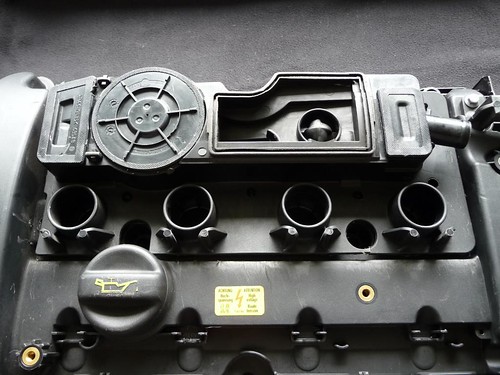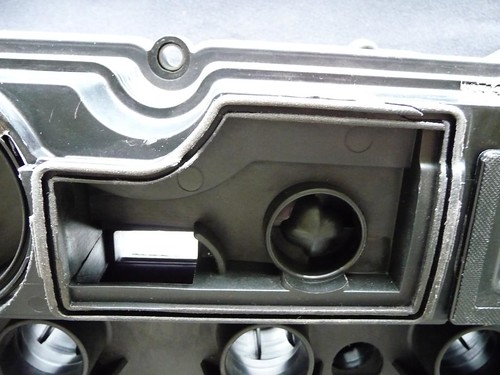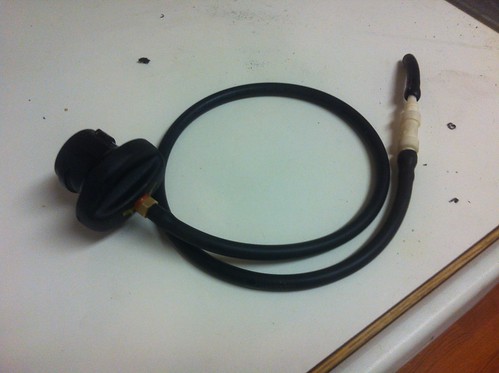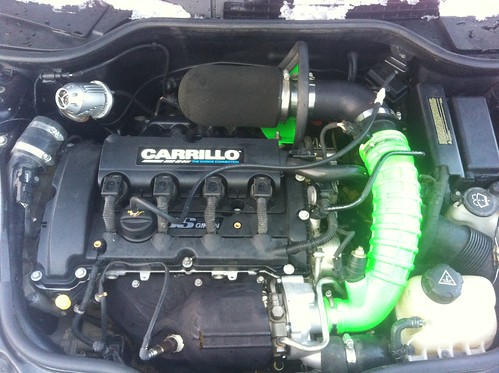PCV Mystery solved!
#1
PCV Mystery solved!
So after all this talk about the PCV system I decided to go grab my valve cover and do a little investigating. Thanks to CZAR for cutting apart one of his valve covers and taking a bunch of pictures (which I tactfully acquired), I can give an even more detailed explanation of what is going on.
Ok so first we have the underside of the valve cover. As you can see in the picture below there are two ways for air to enter/exit the valve cover. The orange circle is a one way valve that will only let air into the valve cover. The white rectangle is an open port that will let air in or out. Mainly this is for air extraction. The white is just a paper towel I stuffed in the port so it would be more visible in the picture.

This is a picture of the extraction area of the PCV system

A view of the extraction port from the top side of the valve cover.

Open and closed flaps on the intake side of the PCV system.


Some pictures of this baffle thing.




Open and closed flaps on the manifold side of the PCV system.


Now that you have seen all the components, I will try to explain how this whole thing works. I sacrificed my lungs and braincells for this, so enjoy.
1. Either the rear or front PCV port can use vacuum to extract air from the valve cover. However neither port can force air into the valve cover.
2.When you block off one port the other is still able to extract air from the valve cover. The front port is more free flowing then the rear.
3.Blocking off the rear port will not cause pressure to build in the valve cover. The pressure will be able to escape from front port.
4.The orange one way valve is slightly confusing. It can only circulate air from the extraction port not air from outside. I think it is used as a way for oil to condense and drain back into the head. That way only fumes escape.
That pretty much sums it up. This should put all of the "PCV system" threads to rest. Questions? Ask away.
Ok so first we have the underside of the valve cover. As you can see in the picture below there are two ways for air to enter/exit the valve cover. The orange circle is a one way valve that will only let air into the valve cover. The white rectangle is an open port that will let air in or out. Mainly this is for air extraction. The white is just a paper towel I stuffed in the port so it would be more visible in the picture.

This is a picture of the extraction area of the PCV system

A view of the extraction port from the top side of the valve cover.

Open and closed flaps on the intake side of the PCV system.


Some pictures of this baffle thing.




Open and closed flaps on the manifold side of the PCV system.


Now that you have seen all the components, I will try to explain how this whole thing works. I sacrificed my lungs and braincells for this, so enjoy.
1. Either the rear or front PCV port can use vacuum to extract air from the valve cover. However neither port can force air into the valve cover.
2.When you block off one port the other is still able to extract air from the valve cover. The front port is more free flowing then the rear.
3.Blocking off the rear port will not cause pressure to build in the valve cover. The pressure will be able to escape from front port.
4.The orange one way valve is slightly confusing. It can only circulate air from the extraction port not air from outside. I think it is used as a way for oil to condense and drain back into the head. That way only fumes escape.
That pretty much sums it up. This should put all of the "PCV system" threads to rest. Questions? Ask away.
Last edited by MNIPWR; 01-16-2013 at 02:16 PM.
The following users liked this post:
cjv2 (12-23-2017)
#3
Thanks for this post, very illuminating.
A comment: Wow, engineering overload much?
I was thinking of and comparing to early PCV systems, circa small-block Chevrolet: 1) vented oil caps, 2) hoses that connect to the oil caps, 3) PCV one-way valve in the hose that 4) connects to the intake manifold for vacuum, 5) other oil cap hose connects to the air cleaner for fresh air supply. One $4-$5 PCV valve to replace when clogged/stuck.
A comment: Wow, engineering overload much?
I was thinking of and comparing to early PCV systems, circa small-block Chevrolet: 1) vented oil caps, 2) hoses that connect to the oil caps, 3) PCV one-way valve in the hose that 4) connects to the intake manifold for vacuum, 5) other oil cap hose connects to the air cleaner for fresh air supply. One $4-$5 PCV valve to replace when clogged/stuck.
#5
I've a question: what's the mystery ?
Your description of the PCV system is somewhat very basic, I think your description of the PCV system using my images should go something like this:
Firstly let me explain a little about the PCV, PCV is an acronym for Positive crankcase ventilation, inside the cam cover there are a few entrapment passages and direction chambers, which do their best to separate the suspended oil particles from the passing vapour, this vapour is then vacuum drawn from the cam cover passageways through a valve flap, the first direction is through the rear PCV line into the intake manifold, next, when the vacuum draw from the turbo (building boost pressure) is greater than the vacuum draw of the induction stroke from the pistons, the rear PCV valve flap is closed, as is the diaphragm in the cam cover, this then changes the direction flow of the vapour, and the vapour is vacuum drawn through the passenger side PCV valve flap into the air intake flow pre-turbo, once off boost and steady throttle is resumed then the vapour is once again vacuum drawn through the rear PCV line.
Now the actual valve flaps themselves are merely free falling self closing rubber diaphragms, there is no spring or piston actuation on either valve flap, however there is a sprung chamber diaphragm, which opens/closes under the vacuum draw from both the inlet manifold and turbo vacuum draw, this dictates the flow direction, and in the later re-designed cam cover allows excess pressure to vent through the inbuilt pressure release sprung valve.
The above is what I wrote to answer a question back in June 2012 I hope this helps clear things up.
Your description of the PCV system is somewhat very basic, I think your description of the PCV system using my images should go something like this:
Firstly let me explain a little about the PCV, PCV is an acronym for Positive crankcase ventilation, inside the cam cover there are a few entrapment passages and direction chambers, which do their best to separate the suspended oil particles from the passing vapour, this vapour is then vacuum drawn from the cam cover passageways through a valve flap, the first direction is through the rear PCV line into the intake manifold, next, when the vacuum draw from the turbo (building boost pressure) is greater than the vacuum draw of the induction stroke from the pistons, the rear PCV valve flap is closed, as is the diaphragm in the cam cover, this then changes the direction flow of the vapour, and the vapour is vacuum drawn through the passenger side PCV valve flap into the air intake flow pre-turbo, once off boost and steady throttle is resumed then the vapour is once again vacuum drawn through the rear PCV line.
Now the actual valve flaps themselves are merely free falling self closing rubber diaphragms, there is no spring or piston actuation on either valve flap, however there is a sprung chamber diaphragm, which opens/closes under the vacuum draw from both the inlet manifold and turbo vacuum draw, this dictates the flow direction, and in the later re-designed cam cover allows excess pressure to vent through the inbuilt pressure release sprung valve.
The above is what I wrote to answer a question back in June 2012 I hope this helps clear things up.
#7
There have been a couple threads lately with reference to OCC an PCV systems. One in particular was blaming exes oil consumption and oil being forced past the turbo seals on blocking off the rear PCV port. Now everyone knows that's blocking off the rear PCV port will not cause the valve cover to pressurize or cause engine damage.
Trending Topics
#9
Very cool to see the internals of a valve cover so thank you to whom ever hacked one up for the greater good. I have a theory on the center diaphragm apparatus. I think it is a maximum vacuum regulator. I believe that when the engine produces more than acceptable levels of vacuum the spring on the diaphragm is overcome, closing the diaphragm and not allowing the crankcase to see the lower vacuum levels on the intake side of the diaphragm. I think the instance this would be needed is when the engine RPM is high and the throttle is closed. See attached super high tech MSpaint drawing for further explanation of my theory.


#10
Valve Cover Pressure (VCP) Test.
I went out and bought an extra oil cap ($10), tapped it for boost, and did some preliminary testing.


Ignore the bad noise. My exhaust needs to be adjusted, it rubs on the sub frame every once and a while.
After driving around for a bit I never experienced positive pressure. Once I started driving around 55Mph I could notice a slight vacuum of maybe half a pound. I stayed out of the boost. Once my engine is broke in I will do it again, and throw a little boost at it. Then I'll put it back to stack and test it that way as well.
I went out and bought an extra oil cap ($10), tapped it for boost, and did some preliminary testing.


Ignore the bad noise. My exhaust needs to be adjusted, it rubs on the sub frame every once and a while.
After driving around for a bit I never experienced positive pressure. Once I started driving around 55Mph I could notice a slight vacuum of maybe half a pound. I stayed out of the boost. Once my engine is broke in I will do it again, and throw a little boost at it. Then I'll put it back to stack and test it that way as well.
#13
Here is the link to my post on the Vacuum pump removal process.
https://www.northamericanmotoring.co...mp-delete.html
It is amazing how little response threads about the functionality and preventative maintenance get vs making stuff look cool threads.
https://www.northamericanmotoring.co...mp-delete.html
It is amazing how little response threads about the functionality and preventative maintenance get vs making stuff look cool threads.
#14
Does the Blow off valve have any direct relation with the pressure inside the valve cover? the reason I ask is because when I plug the rear pcv hose inside the valve cover the rpm starts to fluctuate and its almost like the engine is struggling to breath ,, and when I remove the hose it is back to steady idle .. what causes this situation ,,?
#15
Does the Blow off valve have any direct relation with the pressure inside the valve cover? the reason I ask is because when I plug the rear pcv hose inside the valve cover the rpm starts to fluctuate and its almost like the engine is struggling to breath ,, and when I remove the hose it is back to steady idle .. what causes this situation ,,?
#16
Hi MNIPWR , so what do I do just leave it out sucking in air from the atmosphere? what causes this negative pressuse in the intake ? is there another valve or something that helps the engine replace this negative pressure? is there a blockage somewhere ? does a dirty Throttle body do that?
#17
Hi MNIPWR , so what do I do just leave it out sucking in air from the atmosphere? what causes this negative pressuse in the intake ? is there another valve or something that helps the engine replace this negative pressure? is there a blockage somewhere ? does a dirty Throttle body do that?
You hook it back up. You add a catch can if you don't want to limit the PCV gasses entering the intake manifold. The vacuums is caused by normal operation of the engine. Hook the PCV line back up.
#18
I am confused , in your first reply you said "DO NOT PLUG THE REAR PCV HOSE!" that it would damage my seals ,, and now you are telling me to hook it back up ,, ?!? when I hook up the PCV hose at the moment the RPM starts to flutter and it feels like the engine is strugling to adjust the air intake ,,, then when I uplug the PCV hose it adjusts and the RPM stops fluctuating ,, I tried something else , removing the dipstick with the hose plugged and the RPM didnt fluctuate ,, so to me it seems like the air that is being sucked out of the engine is not being replaced fast enough to keep the RPM from fluctuating at idle. In any other engine configuration , I noticed that there is a breather tube usually for the cranckcase ,, does this N14 engine have one?
#19
I am confused , in your first reply you said "DO NOT PLUG THE REAR PCV HOSE!" that it would damage my seals ,, and now you are telling me to hook it back up ,, ?!? when I hook up the PCV hose at the moment the RPM starts to flutter and it feels like the engine is strugling to adjust the air intake ,,, then when I uplug the PCV hose it adjusts and the RPM stops fluctuating ,, I tried something else , removing the dipstick with the hose plugged and the RPM didnt fluctuate ,, so to me it seems like the air that is being sucked out of the engine is not being replaced fast enough to keep the RPM from fluctuating at idle. In any other engine configuration , I noticed that there is a breather tube usually for the cranckcase ,, does this N14 engine have one?
Yeah, do not plug it. Hook the stock hose back up into the stock locations. Breather tubes are a thing of the past.
#20
What im missing here?
in first post you say that plug on rear has no negative effect, but now you say to not block rear pcv system. What changed in meantime?
About catch can on driver side, I installed there one yesterday, I have stock pcv except that. Today I got 3 liters of oil blown by oil dipstick plug.... I realised catch tank has one way valve inside, but it was installed in correct direction so it allowed escape of wot blow by gases, but apparently blocked completly air flow over crankcase in part throttle or idle so maybe it sucked over valve seals. Looks catch can is to restrictive and there was to much pressure built in crankcase which blown oil dipstick and then oil. I have to verify all of this...
in first post you say that plug on rear has no negative effect, but now you say to not block rear pcv system. What changed in meantime?
About catch can on driver side, I installed there one yesterday, I have stock pcv except that. Today I got 3 liters of oil blown by oil dipstick plug.... I realised catch tank has one way valve inside, but it was installed in correct direction so it allowed escape of wot blow by gases, but apparently blocked completly air flow over crankcase in part throttle or idle so maybe it sucked over valve seals. Looks catch can is to restrictive and there was to much pressure built in crankcase which blown oil dipstick and then oil. I have to verify all of this...
Last edited by caniggia; 12-24-2017 at 04:11 PM.
#21
What im missing here?
in first post you say that plug on rear has no negative effect, but now you say to not block rear pcv system. What changed in meantime?
About catch can on driver side, I installed there one yesterday, I have stock pcv except that. Today I got 3 liters of oil blown by oil dipstick plug.... I realised catch tank has one way valve inside, but it was installed in correct direction so it allowed escape of wot blow by gases, but apparently blocked completly air flow over crankcase in part throttle or idle so maybe it sucked over valve seals. Looks catch can is to restrictive and there was to much pressure built in crankcase which blown oil dipstick and then oil. I have to verify all of this...
in first post you say that plug on rear has no negative effect, but now you say to not block rear pcv system. What changed in meantime?
About catch can on driver side, I installed there one yesterday, I have stock pcv except that. Today I got 3 liters of oil blown by oil dipstick plug.... I realised catch tank has one way valve inside, but it was installed in correct direction so it allowed escape of wot blow by gases, but apparently blocked completly air flow over crankcase in part throttle or idle so maybe it sucked over valve seals. Looks catch can is to restrictive and there was to much pressure built in crankcase which blown oil dipstick and then oil. I have to verify all of this...
The front one you can leave stock. The back one is more important. During normal driving it causes a vacuum on the valve cover. You want to install the catch can so the one way valve points towards the manifold. aka flow from valve cover to manifold. Thats the best set up for a catch can.
#22
#23
I have a stock 2007 Mini cooper S R56 Turbocharged and I am wondering if someone can tell me why is it when I hook up the PCV hose to the back of valve cover, at the moment the RPM starts to flutter (moves up and down) at idle and it feels like the engine is strugling to adjust the air intake ,,, then when I uplug the PCV hose it adjusts and the RPM stops fluctuating and it feels normal again? ,, I tried removing the dipstick with the hose plugged and the RPM didnt fluctuate
#25
I never plugged it but I think the old valve cover had the damaged pcv valve in it that was damaged or socked with oil and I replaced that ,, and now I am taking the intake manifold off to clean all the oil out and to clean the throttle body ,, I noticed the pcv hose that goes from the rear valve cover to the intake leaked out lot of oil when I tried to unplug it from the manifold,, so I decided to replug it to the manifold to limit the oil mess and take the whole manifold off and clean everything then rehook it ,, and try to run it again ,, I;ll try your suggestion ,, but so I understand correctly you want me to try and plug the pcv hose and start the car and let it idle for 15 min even tho the RPM will fluctuate ? I will unplug the battery and replug it ,, before I restart .,,



 I'll move catch can to passenger side and to driver side I'll install without valve and 3/4 hoses/holes to not block system. Additionally I'll verify valve cover to check if is not chocked.
I'll move catch can to passenger side and to driver side I'll install without valve and 3/4 hoses/holes to not block system. Additionally I'll verify valve cover to check if is not chocked.